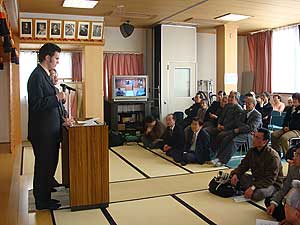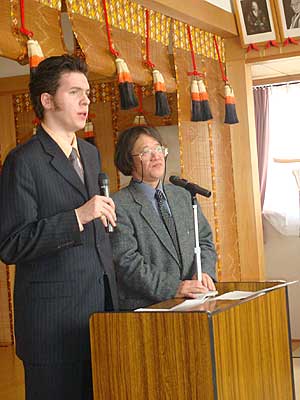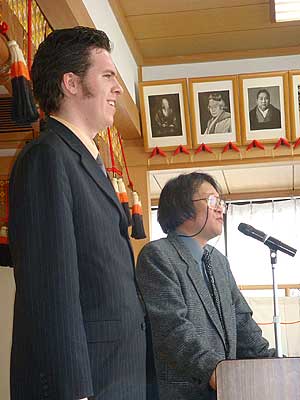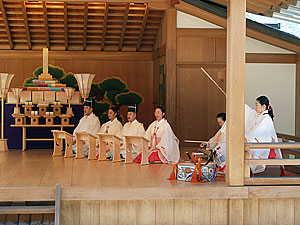Planting the Seeds of the Soul
by Neil Ryan Walsh
During Neil’s one month stay at Oomoto headquarters in Kameoka he made two speeches, one at the Nagoya chapter and another at the Kobe branch. As the introductory portions of these two speeches was similar it has not been included in this text, for Mr. Walsh’s introduction to Oomoto please see his speech at the Nagoya branch.
“The physical world is the seedbed, and our souls are the seeds…One must sow them at the appropriate place in the appropriate season.”
Hidemaru Deguchi, In Search of Meaning.
Waiting for the Right Season to Planting the Seeds of the Soul
Over the past few weeks I have been reading In search of Meaning by Hidemaru Deguchi and think it is a great spiritual masterpiece. I would like to see it be made more widely available to an international audience.
I keep reading some of the passages over and over, reflecting on them and their relevance to my life. "In Search of Meaning" is one of the most profound spiritual books I have ever come across, and I have read many such books.
I would like to see these teachings spread around the world, and would like to see this book available in bookstores in New York, or in the English book section of Kinokuniya in Tokyo. I would also like to see the writings of all Oomoto spiritual leaders and more of the sacred writings translated as well.
I have been interested in Shinto since I first read about it in high school. It was only when I entered Sophia University in 2002 that I began to study Japanese religion within the context of Japanese history in depth. At that time I also visited and prayed at many shrines and enjoyed several Matsuri around Tokyo, and even carried an Omikoshi in one.
At the end of that school year, I visited the Mt. Inari (Inariyama) in Kyoto city, where I had an experience that deepened my appreciation of Shinto. I was in awe of the number of torii -- large torii, small torii, tori in front of every tree and rock, torii inside of torii, and inside of torii.
I thought about the nature of God being everywhere, and about the hopes and dreams of all of the hundreds of thousands of people who had dedicated torii there. For me it was an experience of the divine as omnipresent made manifest by bright red gates.
When I returned to the United States, I kept up my interest in Japan, specifically for Japanese religion for about a year by reading books on the subject, but was not able to sustain it much after that. I did have some Japanese friends in New York, but seldom spoke Japanese at all.
I returned to Japan after completing my master’s degree in psychology mostly because I wanted to continue to pursue the interest in Japanese culture I was not able to keep up with while I was in graduate school. It was a big decision for me to make as I had to leave a lot of what I was doing in New York behind.
I actually made the decision to return to Japan when I was in Egypt, of all places.
I remember driving around Cairo for hours in a taxi as hot as an oven. We were on a circuitous route at the height of traffic. As I looked out the window I was in awe of the fact that nothing outside the car window was recognizable; the food, clothing, language and customs were all a mystery to me. The only other time in my life I had such an experience was on my first trip to Japan.
The feeling is both bewildering and exciting at the same time; I had a feeling that everything I had previously assumed about the world was to be questioned, and everything about the new culture I was in was to be explored and considered seriously. I made the decision in that taxi that I wanted to spend the rest of my life studying culture. I thought a long time about “which” culture to study. I had already spent a lot of time studying Japanese culture, and still had many things in Japan that I was interested in and wanted to learn more about, particularly Shinto and Buddhism.
I was in Cairo representing psychologist Dr. Judy Kuriansky, a former radio advice host who in the past few years has recently turned to researching ways psychology can contribute to world peace.
Dr. Judy, as I call her, was writing a book about the Israeli-Palestinian conflict, an area I had always been interested in, and she needed someone to represent her at a psychiatric conference. She asked me at the last minute, and I jumped at the once in a lifetime opportunity.
Little did I realize that this trip to Cairo would lead me to write two articles on the psychological aspects of the Israel-Palestine conflict for two books edited by Dr. Judy. Later, I was even more surprised to learn that among the Japanese, Oomoto is at the forefront of promoting Middle East peace.
I believe this chance to study with Oomoto and my peripheral involvement in the Middle East peace process are divine blessings; this is the reason I have taken advantage of the opportunity to volunteer at Oomoto’s International Division.
Hidemaru Deguchi offers the following, “If you are inclined to say, ‘I just have an unexplainable feeling about this,’ your inspiration is coming from the spirit world and chances are you would be better off following this kind of hunch.”
If I had not followed the initial hunch I had to keep in contact with Bill and visit Oomoto I would never have been able to meet any of you today. I believe that this is a gift from the spirit world for which I am truly grateful.
He also writes, “The physical world is the seedbed, and our souls are the seeds…One must sow them at the appropriate place in the appropriate season.”
I believe that I have long had a soul for Shinto but I did not have an appropriate place to sow the seeds of my soul until I encountered Oomoto, where I gladly sow these seeds. I also feel that my experiences at Oomoto have given me more seeds to sow. I hope that some of these seeds help me to contribute not only to my own personal development, but to world peace, hopefully starting with peace in the Middle East.
The circumstance that led me to Oomoto can not be explained simply in rational terms. I choose to believe that there was an element of the divine involved in my meeting Oomoto and becoming involved with the activities of the international department. I studied psychology, understand the importance of science and firmly believe that the rigors of the scientific method a standard that should be upheld.
At the same time there is too much that can not be explained by science or rationalism alone and this is where religion is important. Religion and belief in the spirit world helps people to appreciate a different dimension beyond what we can see or think.
I want to illustrate this point with another quote from Hidemaru, “It is being too hasty to conclude that if the human eye or ear cannot detect something, then it does not exist. We cannot know…what sounds lie beyond our stethoscopes.
As for the idea that the circumstances surrounding my meeting Oomoto were somehow related to divine fate following quote from Hidemaru sensei was inspiring, “Man is always plotting this or planning that, and I ask you how often such things work out as planned? It is destiny, not ourselves, that controls the eventuality.
Tending the Garden
Oomoto has many gifts to offer Japan and the world. For example, Oomoto's non-professional priesthood is a brilliant institution. Any Oomoto member with the basic training can serve as a priest.
This keeps Shinto traditions alive not only in the sect as a whole, but in the families. If a father can teach his son or daughter the priestly arts, the religious traditions are passed to another generation. In many of my friends’ houses here in Japan, Kamidana and Butsudan appear to be largely taken for granted.
I have heard that many Japanese Shinto and Buddhist households do not have a Kamidana (Shinto altar) or a Butsudan (Buddhist altar). Many young people do not feel a connection with the Buddhist and Shinto practices or their institutions.
The fact that many Oomoto followers are intimately familiar with the actual rituals and scriptures of their traditions is vital for ensuring the future of Oomoto practices.
I am also impressed that so many people in Oomoto actively promote and practice the Japanese arts and that Oomoto has held art exhibitions in Europe and America. Oomoto followers seem to be deeply respectful of their own culture and deeply respective of other cultures at the same time.
This respect also extends to other religions. Oomoto not only preaches Bankyo Dokon, but lives the message in its practice.
The efforts to make Onisaburo Deguchi’s vision of the world manifest through the work of Aizenkai are a testament to the faith of Oomoto followers. That organization’s efforts on international development, interfaith dialogue, and Esperanto are significant considering the actual size of Oomoto.
Bill Roberts, who wrote A Portrait of Oomoto, has become a cherished friend of mine over the past year and a half. My introduction to and understanding of Oomoto would never have been made possible without him and his book.
One theme that runs through his book is his awe of the impact Oomoto has on Japan and the world despite its relatively small size. Oomoto is a shining example that a small group of people with strong faith in the divine and a positive attitude can contribute to world peace and can actualize their vision of an ideal world.
One common concern I have heard from nearly all Oomoto followers is the size of Oomoto’s membership and its future. I understand that the situation for religions in Japan is difficult. Many Japanese have a negative perception of "New Religions." It is difficult to spread your teachings in this environment.
As I see it, Oomoto followers have two challenges ahead. One is to communicate your message to the outside world. The other is to work to ameliorate the negative image of religion in Japan.
Japan as a nation is currently facing many widespread social problems and many Japanese individuals face personal -- psychological problems; futoukou, hikikomori, suicide, depression, and problems with marriage just to name a few. Religious counseling and spiritual advisement can be a great help to many people facing problems. I encourage Oomoto to look for ways to bring these teachings to groups and individuals outside Oomoto.
I have already given enough examples above of how impressed I am at current efforts being made by Oomoto. I believe that Oomoto provides a variety of examples of how to live a dignified life, and hope that these examples can be spread around the world. I firmly believe that a peaceful world can be realized through small efforts. I would like to be a part of these grassroots efforts to change the world; I believe that having the chance to spend time at Oomoto gives me a precious opportunity to experience such efforts first hand. I have a learned a lot from Oomoto already and still have a lot more to learn. I hope that my relationship can continue for years to come.



New Contents Thu, May 20, 2010
- Oomoto participates in Sant’Egidio conference : Dialogue among religions and cultures : On divided island nation of Cyprus By Bill Roberts
- Photo Album : Portraits of three branches: Shoko, Tanegashima and Aomori By Bill Roberts
- Oomoto FAQ
- A Letter from Oomoto : Of mountains and myths By Bill Roberts
- Polyglot poem festival The Utamasturi is going international — what’s next? By Bill Roberts
- Ethics education program captures the spirit of Bankyo Dokon By Bill Roberts
- A Letter from Oomoto : A year’s worth of adventure in a summer of branch visits By Bill Roberts
- In Kumamoto, it’s all about water – and fire By Bill Roberts
- A speech by Nevada Taylor at the Kii Branch in Wakayama Prefecture on April 13, 2008.:An Encounter With Oomoto Through Aikido
- Utamatsuri, Poem Festival, in Tokyo(on April 17, 2008)
- A speech by Neil Ryan Walsh at the Kobe branch on Mar. 9th, 2008.:Planting the Seeds of the Soul
- Meeting with the Fifth Spiritual Leader of Oomoto, Madame Kurenai Deguchi by Neil Ryan Walsh
- A speech by Neil Ryan Walsh at the Nagoya branch on Feb. 17th, 2008.:The Japanese Arts beyond National Boundaries
- To the Oomoto branch in Nagoya: City of Eel and Toyota by Neil Ryan Walsh
- A Speech by Nissim Ben Shitrit, Ambassador of Israel on the occasion of the Oomoto Setsubun Grand Festival in Ayabe February 3rd, 2008 : Japan and Israel : Two Lands Balancing the Needs of Traditional Culture and Modern Life. r
- A permanent memorial to Onisaburo (A Speech at the Autumn Grand Festival , November 6, 2007 : )By James Parks Morton, Founder and Chair, Emeritus of The Interfaith Center of New York
- Israel, Palestine and the Power of Poetry(Oomoto believes small efforts can have lasting ripple effects on people and peace)By Bill Roberts
- “Something Great”(This genetics pioneer, a friend of Oomoto, offers a clue to the mystery of life)By Bill Roberts
- Kamishima Cleanup (Harima branch members regularly visit this sacred island to keep the shrine tidy)By Bill Roberts
- Kyotaro Deguchi was one of six recipients of the 2007 James Parks Morton Interfaith Award
What is Oomoto?
- What is Oomoto?
- Spirtual Centers
- Founders and Spiritual Leaders
- History
- Organization and activities
- Teachings and scriptures
- Art Works of Founders and Leaders
Opinions[Archive]
- Statement of regret for the outbreak of war against Iraq (March 20,2003)
- Jinrui Aizenkai dispatched the "Urgent Appeal for a World (Global) Crisis" on March 14.
Grappling with Bioethics[Archive]
- Oomoto’s support for abolishing the death penalty (12, June 2003)
- The Oomoto Foundation protests any birth of a human clone baby. (5, January 2003)
- OOMOTO'S VIEW REGARDING JAPAN’S PERMITION TO THE RESERCH OF HUMAN EMBRYONIC STEM CELLS (ES cells)(12, June 2000)
Vistor’s Review[Archive]
- A speech by Bill Roberts at the Oomoto branch in Hiroshima after its monthly service on March 18, 2007:Encounters with war and peace
- How Bankyo Dokon changed one life by Linda Macphee
- A speech by Bill Roberts at the Hokuriku (Kanazawa) branch on Dec. 3, 2006:Ritual and myth -an encounter with ‘divine madness’
- A speech by Bill Roberts at the Himeji Cultural Center on Feb. 25, 2007:Mesmerized by the Japanese Arts
- A speech by Bill Roberts at the Kobe branch on Feb. 11th, 2007.:There are just human tears and human joy
- A Speech on the occasion of the Oomoto Setsubun Grand Festival in Ayabe February 3rd, 2007 : Egypt's role in Middle East peace
- Keynote Speech for the 28th World Federation Japanese Religionists Conference for World Peace in Tokyo (at Kokugakuin University, Novermber 29, 2006):Vision for Peace in the Middle East By Dr. Munther S. Dajani, Professor Dean, Faculty of Arts, Al Quds University, Jerusalem
- A speech to the Kyoto branch:Spiritual adventures in researching Oomoto leaders
- A Speech at The Oomoto Foundation on Monday, November 6, 2006 : Jordan's role in Middle East By Samir Nouri, Ambassador of the Hashemite Kingdom of Jordan
- A letter from Oomoto:The Young People of Tottori
- A speech by Bill Roberts on the occasion of the dedication ceremony for the new shrine of Tottori Branch By Bill Roberts Oct. 8, 2006
- A speech by Bill Roberts at the Oomoto branch in Hiroshima after its monthly service on March 18, 2007:Encounters with war and peace
- How Bankyo Dokon changed one life by Linda Macphee
- A speech at Setsubun : A Portrait of Oomoto By Bill Roberts Feb. 3, 2006
- New Publication ! By Bill Roberts Feb. 3, 2006 A Portrait of Oomoto
you can read this book in html => http://www.jinruiaizenkai.jp/English/en-kolumno/en-bill/en-sugao/billbook1en.html
E-mail below to order brobert1@ix.netcom.com
Current Topics
- Prayer Offering and World Religious Forum II
- Living the art of dialogue
- Kyotaro Deguchi was one of six recipients of the 2007 James Parks Morton Interfaith Award
Books
Online Books
- Divine Signposts by Onisaburo DEGUCHI
- The Creation of Meaning by Hidemaru Deguchi
- Bankyo Dokon(Seventy years of Inter-Religious Activity at Oomoto)
- Nao Deguchi — A Biography of the Foundress of Oomoto
- The Great Onisaburo Deguchi published by Aiki News
- Bankyo Dokon Seventy Years of Inter-Religious Activity at Oomoto
- Insearch of Meaning
- Nao Deguchi A Biography of the Foundress of Oomoto
- A Portrait of Oomoto By Bill Roberts
Oomoto international Archive
- The History of Oomoto (Jan.– Mar. 1980 — Apr.– Jun. 1982)
- The Ancestors; Friends or Foes? (Apr.– Jun. 1987)
- Tsukinamisai; The Sabbath of Shinto (Jan.– Jun. 1983)
- The Poem Festival at Oomoto; An Ancient Rite Lives Again (Oct.– Dec. 1981)
- Purification of the Universe ; Oomoto's Setsubun Festival (Apr.– Jun. 1981)
Links
Flowers at Ten'on-kyo & Baisho-en (photographs)
Contact
All rights reserved : the Oomoto Foundation Produced by the Netinformational Commission
Since : Mar. 7.1998 Last Update : Thu, May 20, 2010
E-mail : webmaster@oomoto.or.jp
Top Page Nihongo Esperanto Português Roomazi



